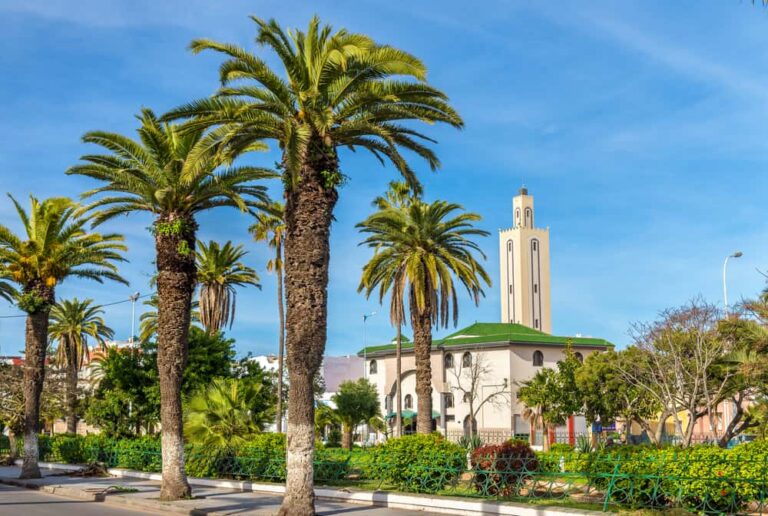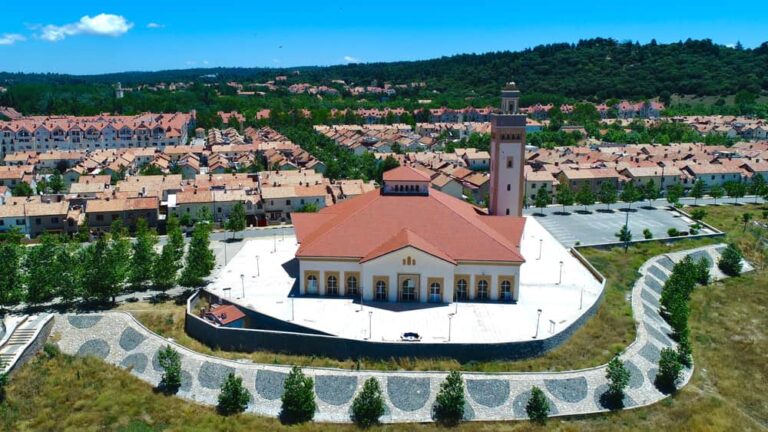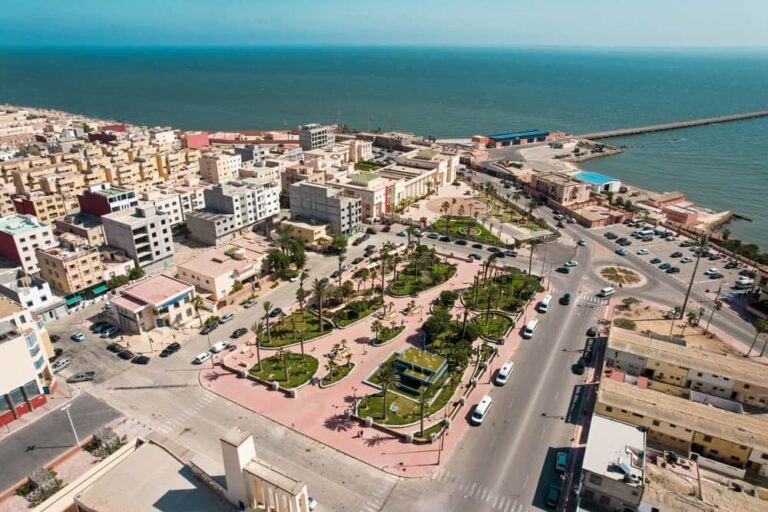Dades Valley & Gorges

The Dades Valley & Gorges is one of Morocco’s hidden gems. Nestled in the High Atlas Mountains, this stunning area offers breathtaking landscapes, rich culture, and exciting adventures. Travelers often describe it as a place where nature meets history, with towering cliffs, dramatic rock formations, and traditional Berber villages.
The Dades River winds its way through the valley, creating lush oases in the middle of an otherwise rocky and dry landscape. Along the river, visitors can find ancient Kasbahs—fortified homes made of clay and straw—standing tall as reminders of Morocco’s past. The valley is also home to the famous “Monkey Fingers,” unusual rock formations shaped by wind and time.
In addition to its natural beauty, the Dades Valley offers visitors a chance to experience authentic Berber culture. You can explore Aït Oudinar, meet local people, and learn about their way of life. The valley’s scenic drives, with their winding roads and sharp hairpin turns, offer panoramic views of the landscape that leave travelers in awe.
Whether you’re a nature lover, a photographer, or just looking for adventure, the Dades Valley & Gorges has something for everyone. In the following sections, we’ll explore the valley’s stunning landscapes, its ancient villages, and the many activities it has to offer.
Best Places to Visit in Dades Valley and Gorges
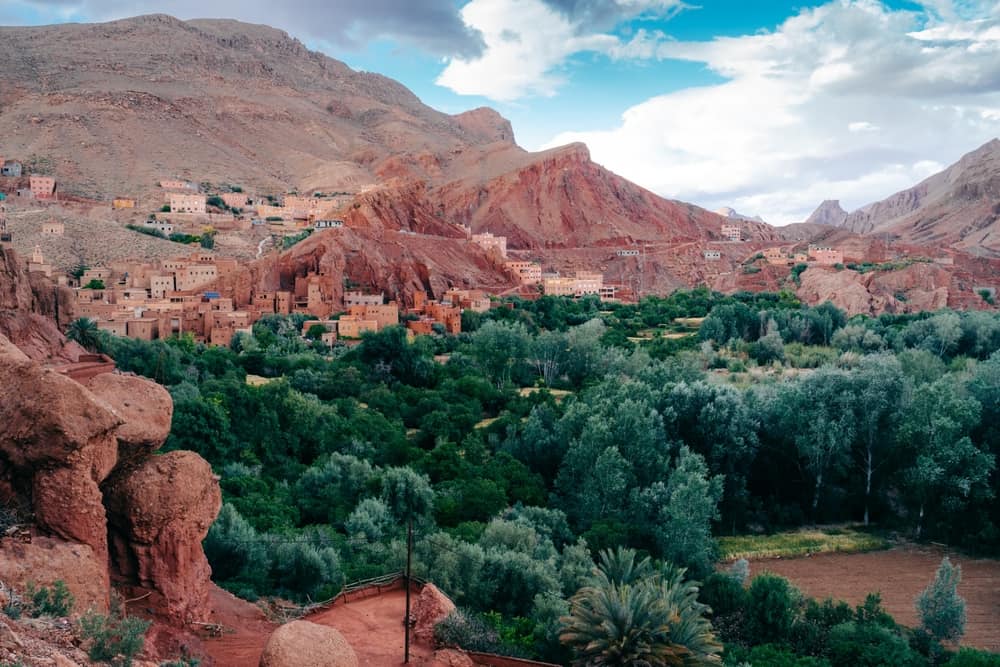
1. Dades Gorge
The Dades Gorge is one of the most spectacular sights in the valley. It’s a deep canyon carved by the Dades River, featuring dramatic rock formations and towering cliffs that reach over 500 meters in some places. The gorge is known for its winding road with sharp hairpin turns, making the drive through the gorge both thrilling and scenic. Along the way, you’ll pass ancient kasbahs, small Berber villages, and lush oases that offer a striking contrast to the red, rocky landscape. Visitors often stop at the viewpoints along the road to capture the breathtaking panoramic vistas of the valley.
For hikers, the Dades Gorge offers several trails that take you deeper into the canyon. The hikes range from short walks to more challenging treks that offer unique perspectives of the gorge and its rock formations. The Monkey Fingers rock formation is one of the most popular sites within the gorge, known for its unusual shapes that resemble human fingers.
2. Monkey Fingers Rock Formation
The Monkey Fingers rock formation is one of the most famous natural landmarks in the Dades Valley. This unique geological feature gets its name from its rounded, finger-like appearance, caused by centuries of erosion from wind and water. The red rock formations are located in the heart of the Dades Gorge and are a popular spot for both hikers and photographers.
Visitors can hike around the Monkey Fingers, following trails that lead through narrow passages and up to viewpoints where the formations can be viewed from above. The hike to the Monkey Fingers is relatively easy and can be done in a few hours, making it a perfect stop for families and casual hikers. The area also provides great opportunities for rock climbing, as the formations offer unique and challenging surfaces to scale.
3. Aït Oudinar
Aït Oudinar is one of the traditional Berber villages in the Dades Valley, and it’s an excellent place to experience the authentic rural life of the region. The village is small but full of charm, with houses made of mud and straw that blend seamlessly into the surrounding landscape. The Berber people in Aït Oudinar are known for their warm hospitality, often welcoming visitors with mint tea and traditional Berber meals.
Staying in Aït Oudinar is an opportunity to immerse yourself in Berber culture. Many guesthouses in the village offer homestays, where you can participate in daily activities like farming, cooking, and even rug-making. The village also serves as a base for exploring nearby hiking trails, including routes that lead to the Monkey Fingers and Dades Gorge.
4. Ait Youl Kasbah
The Ait Youl Kasbah is one of the most well-preserved kasbahs in the Dades Valley. Kasbahs are large, fortified homes that were traditionally built by Berber tribes to protect their families and livestock. Ait Youl is a fine example of Moroccan architecture, with its thick mud walls, narrow passageways, and multiple courtyards. The kasbah has been partially restored and now serves as a cultural and historical site where visitors can learn about the region’s history.
Exploring the Ait Youl Kasbah offers a glimpse into the valley’s past, as these buildings once played a crucial role in the social and economic life of the region. Many kasbahs, like Ait Youl, have been converted into guesthouses, allowing visitors to spend the night in these ancient structures and experience the unique architecture up close.
5. Boumalne Dades
Boumalne Dades is the gateway town to the Dades Valley and serves as a starting point for most visitors exploring the region. This small town is located at the mouth of the Dades Gorge and offers a range of accommodations, from budget guesthouses to more luxurious kasbah-style hotels. It’s also a great place to stock up on supplies before heading into the more remote areas of the valley.
Boumalne Dades is home to several Berber markets, where you can find local handicrafts, food, and traditional clothing. The town is also a hub for guides and tours, offering visitors a chance to book excursions into the Dades Valley and beyond. From Boumalne, you can easily access the valley’s main attractions, such as the Monkey Fingers, the Dades Gorge, and the scenic roads leading further into the High Atlas Mountains.
6. Road of a Thousand Kasbahs
The Road of a Thousand Kasbahs is one of the most scenic drives in Morocco, stretching from Ouarzazate to Boumalne Dades and further into the Dades Valley. Along this route, you’ll see countless kasbahs, which are fortresses made of mudbrick, dotting the landscape. These kasbahs were once homes to powerful Berber families and played an important role in the region’s defense and trade.
Today, many of these kasbahs have been converted into guesthouses or historical sites, allowing visitors to stay overnight and experience life inside these traditional fortresses. The Road of a Thousand Kasbahs offers spectacular views of the Atlas Mountains, oases, and valleys, making it a must-see for anyone traveling through the Dades Valley. The winding road itself is an adventure, with sharp turns and narrow passages that offer dramatic views of the surrounding cliffs and rock formations.

7. Dades River
The Dades River is the lifeblood of the Dades Valley, providing water to the lush oases that line the valley floor. The river cuts through the rocky landscape, creating a fertile ribbon of green in an otherwise arid environment. Visitors can follow the river on foot or by car, stopping to enjoy the scenic views of the valley and the surrounding mountains.
The Dades River is also a popular spot for birdwatching, as many species of birds, including birds of prey like falcons and eagles, can be seen flying overhead or resting in the trees along the riverbanks. The river’s gentle flow provides a peaceful backdrop for hiking or picnicking, making it a great spot to relax and enjoy the natural beauty of the valley.
8. Hiking Trails and Adventure
The Dades Valley is a hiker’s paradise, with trails ranging from easy walks to more challenging routes through the gorges and mountains. One of the most popular hikes is through the Dades Gorge, where you can follow the river as it winds through the narrow canyon. Along the way, you’ll pass through Berber villages, oases, and towering cliffs.
For more experienced hikers, the nearby High Atlas Mountains offer a range of more challenging trails, including routes to Mount Toubkal, the highest peak in North Africa. The Dades Valley is also a great place for mountaineering and rock climbing, with the Monkey Fingers and other rock formations providing unique climbing opportunities.
These destinations and activities make the Dades Valley & Gorge a truly unforgettable experience, offering visitors a blend of natural beauty, adventure, and rich cultural heritage.
Stunning Natural Landscapes of Dades Valley
The Dades Valley is famous for its stunning natural beauty. As you journey through the valley, you will see a landscape that constantly changes—from wide open spaces to towering cliffs. The Dades River flows through the valley, creating green oases that stand out against the red, rocky terrain. This contrast between the lush valley floor and the dry, rugged mountains is one of the most unique features of the region.
Seasonal changes make the valley even more interesting. In the spring, wildflowers bloom, adding vibrant colors to the landscape. In the winter, snow covers the peaks of the High Atlas Mountains, creating a dramatic backdrop for the valley. No matter what time of year you visit, the views are sure to be breathtaking.
Photographers love the Dades Valley for its variety of panoramic views. From the red rocks and cliffs to the lush greenery of the oases, there are endless opportunities to capture the beauty of nature. Whether you’re a professional or just snapping photos on your phone, you’ll find plenty of amazing scenes to shoot.
Dramatic Rock Formations
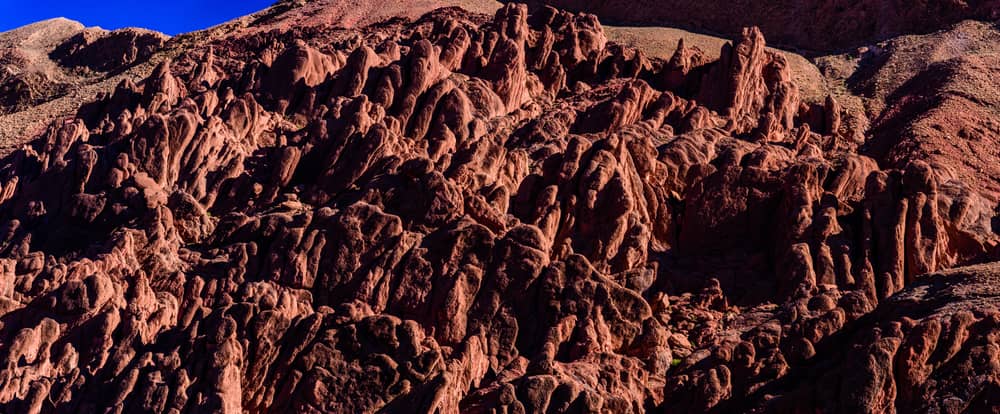
One of the highlights of the Dades Valley is its dramatic rock formations. The most famous is the “Monkey Fingers” formation, a series of red, rounded rocks resembling fingers reaching the sky. These unusual formations were shaped by wind and water over millions of years. Visitors often hike through the area to get a closer look at these natural wonders.
In addition to the Monkey Fingers, the valley is home to towering cliffs and narrow gorges that the Dades River has carved out. The sharp contrasts between the smooth river and jagged rocks create a harsh and beautiful landscape. These rock formations are not only impressive to look at, but they also tell the story of the valley’s geological past.
Hiking along the cliffs and through the gorges gives you a chance to see these formations up close. You’ll feel like you’ve stepped into another world as you explore the narrow, winding paths that take you deep into the heart of the valley.
Traditional Berber Villages
The Dades Valley is dotted with traditional Berber villages, where you can experience a way of life that has remained largely unchanged for centuries. These villages, such as Aït Oudinar, are made up of simple homes built from mud and straw, blending into the landscape. The Berber people have a deep connection to the land, and their culture is rich with history and tradition.
In these villages, you’ll have the chance to meet local families and learn about their customs and daily lives. Hospitality is an important part of Berber culture, and visitors are often welcomed with mint tea and homemade meals. You can explore the narrow streets of the villages, visit local markets, and see artisans at work, making traditional crafts such as rugs and pottery.
Staying in a Berber village gives you a glimpse into a lifestyle that is deeply rooted in the past. It’s a chance to step back in time and experience a slower, more peaceful way of life.
Historic Kasbahs
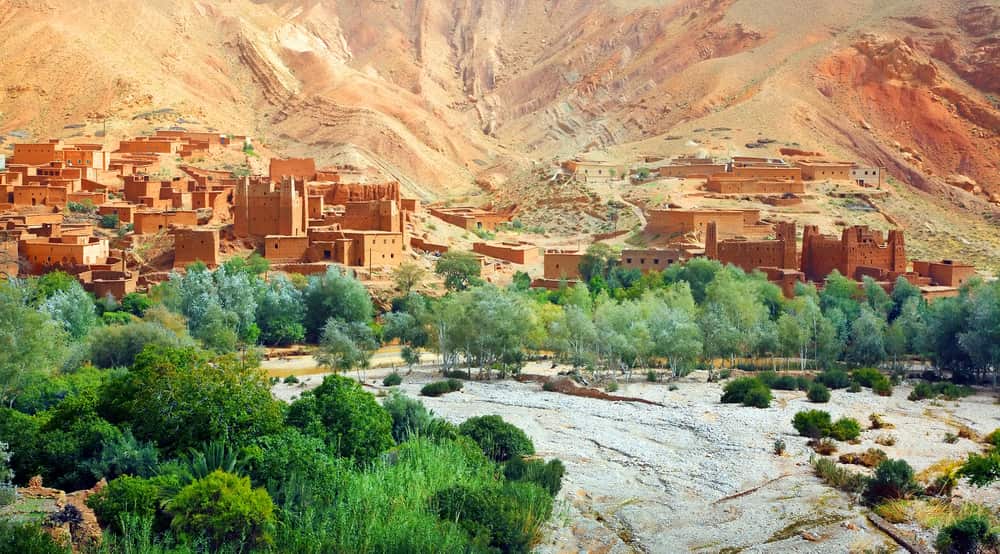
Throughout the Dades Valley, you’ll find historic kasbahs, which are large, fortified homes built by Berber tribes. These kasbahs were once centers of power and wealth, where local rulers lived and protected their communities. One of the most famous kasbahs in the region is Ait Youl, which has been well-preserved and offers a fascinating look into the region’s past.
These structures are made from mud bricks and have thick walls to keep out enemies and the harsh desert climate. Many of the kasbahs have been restored and are now used as guesthouses, where visitors can stay overnight and experience what it was like to live in a kasbah.
Exploring a kasbah is like walking through history. You can wander through the narrow corridors, climb up to the rooftops for stunning views of the valley, and imagine what life was like hundreds of years ago. Staying in one of these historic buildings is a unique way to connect with the region’s past while enjoying the comforts of the present.
Scenic Drives and Hairpin Turns
One of the most exciting ways to explore the Dades Valley is by car. The scenic drives through the valley are known for their breathtaking views and sharp, winding roads. The Dadès Gorge Road, also called the “Road of a Thousand Kasbahs,” is a famous route that takes you past ancient kasbahs, stunning rock formations, and through the narrow gorge.
As you drive along the road, you’ll encounter hairpin turns that twist and turn through the cliffs. The views from these turns are spectacular, with panoramic vistas of the valley below. It’s a thrilling experience, but drivers need to be careful, especially on the narrow parts of the road.
The best time to take this scenic drive is during the spring or fall, when the weather is mild, and the views are at their best. It’s a journey that offers both adventure and beauty, with something new to see around every corner.
Outdoor Adventure and Hiking Opportunities
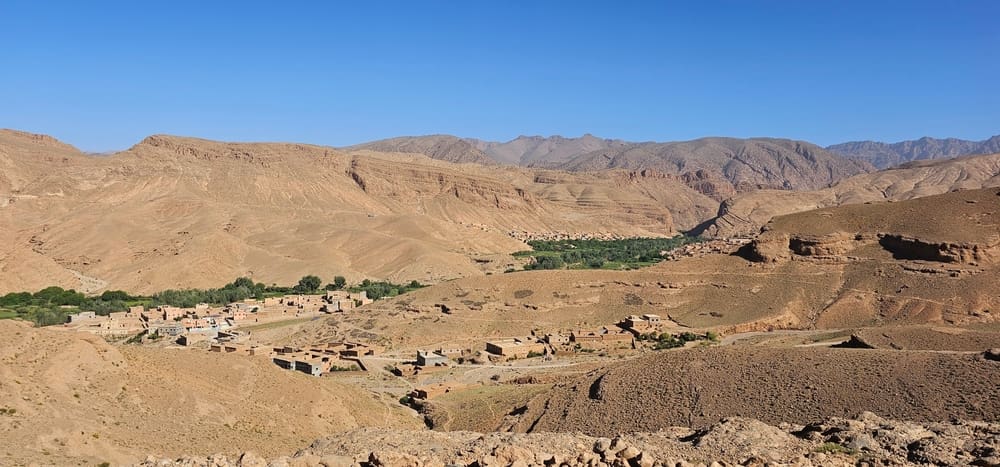
For those who love the outdoors, the Dades Valley is a paradise. The valley is home to numerous hiking trails that range from easy walks to challenging climbs. Whether you’re looking for a short, scenic stroll or a full-day adventure, there’s a trail for every level of hiker.
One of the most popular hikes is through the Dadès Gorge, where you can follow the river as it winds through towering cliffs. Along the way, you’ll pass through lush oases, small Berber villages, and dramatic rock formations. The valley is also a great place for mountaineering, with the nearby High Atlas Mountains offering challenging climbs for experienced adventurers.
No matter what type of outdoor activity you enjoy, the Dades Valley offers endless opportunities to explore its natural beauty. From hiking and climbing to simply enjoying a picnic by the river, it’s the perfect destination for nature lovers.
Cultural and Ecotourism Experiences
In addition to its natural beauty, the Dades Valley offers a rich cultural and ecotourism experience. Visitors can learn about Berber culture, which is deeply connected to the land. Many villages in the valley offer ecotourism programs that allow travelers to experience the local way of life while supporting sustainable travel practices.
Staying in a Berber village gives you a chance to participate in daily activities like farming and cooking. You can also take part in traditional Berber festivals, which are full of music, dancing, and celebration. These experiences provide a deeper understanding of the valley’s culture and history.
Ecotourism in the Dades Valley helps support local communities by promoting sustainable travel. By choosing to stay in eco-friendly accommodations and participating in local activities, visitors can help protect the environment while experiencing the valley’s unique culture.
Wildlife and Birdwatching
The Dades Valley is home to a wide variety of wildlife, including many species of birds. Birdwatchers will find plenty of opportunities to spot rare and migratory birds, especially in the oases and along the Dades River. Birds of prey, such as eagles and falcons, are often seen soaring above the valley’s cliffs.
In addition to birds, the valley is home to other animals, such as foxes, wildcats, and reptiles. Exploring the valley’s wilderness gives visitors a chance to see these animals in their natural habitat. Whether you’re a seasoned birdwatcher or just enjoy seeing wildlife, the Dades Valley is a great place to connect with nature.
Photography Opportunities
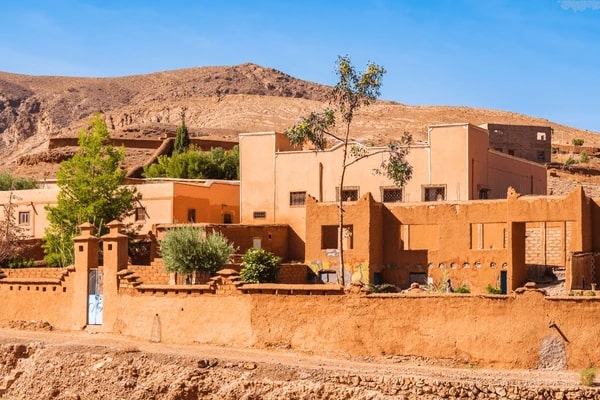
With its stunning landscapes, unique rock formations, and traditional villages, the Dades Valley is a photographer’s dream. There are countless opportunities to capture the beauty of the valley, from the panoramic views of the mountains to the close-up details of the ancient kasbahs.
The best times for photography are during the early morning and late afternoon when the light is soft and the colors of the landscape are most vibrant. Whether you’re taking wide-angle shots of the valley or focusing on the details of a Berber village, you’ll leave the Dades Valley with a collection of unforgettable images.
Authentic Rural Experience in the Dades Valley
The Dades Valley offers an authentic rural experience that gives visitors a chance to step back in time. Staying in a local guesthouse or Berber homestay allows you to experience the simple, peaceful life of the valley’s residents. You can learn how to cook traditional Moroccan meals, help with farming, or simply enjoy the quiet beauty of the valley.
Many travelers come to the Dades Valley to escape the hustle and bustle of city life. The valley’s rural charm, combined with its rich history and culture, makes it a perfect destination for those looking for a more authentic travel experience.
Difference Between Dades Gorge and Todra Gorge
The Dades Gorge and Todra Gorge are two of Morocco’s most famous natural attractions. While both gorges offer stunning views and exciting hikes, there are some key differences. Dades Gorge is known for its winding roads and dramatic rock formations, while Todra Gorge is famous for its towering cliffs and narrow passages.
If you’re looking for a scenic drive with plenty of places to stop and take photos, the Dades Gorge is a great choice. On the other hand, if you’re interested in a more challenging hike, Todra Gorge offers steeper cliffs and more rugged terrain. Both gorges offer unique experiences, and many travelers choose to visit both during their trip to Morocco. Dades Gorge is often quieter and less crowded, making it a great option for those looking for a more peaceful adventure. Todra Gorge, being more popular, tends to have more visitors, but it also offers excellent opportunities for rock climbing and more intense hikes.
No matter which gorge you choose to explore, you’ll be treated to breathtaking views, dramatic landscapes, and a memorable outdoor experience. Both are perfect for nature lovers and adventurers looking to immerse themselves in Morocco’s natural beauty.
Practical Information for Visiting Dades Valley & Gorges
Planning a trip to the Dades Valley & Gorges requires some preparation to ensure you make the most of your visit. First, consider the best time to go. The ideal time to visit is during the spring and fall when the weather is mild, and the landscapes are most vibrant. Summers can be extremely hot, while winters can be cold, especially in the higher elevations of the Atlas Mountains.
Getting to the Dades Valley is relatively easy from major Moroccan cities like Marrakech or Ouarzazate. You can rent a car and drive yourself, or hire a guide who can take you through the valley’s scenic roads. The drive from Marrakech takes about six hours, while it’s a shorter trip from Ouarzazate, at around two hours.
It’s a good idea to book your accommodation in advance, especially during the high season. There are several options, ranging from traditional kasbah guesthouses to modern hotels. If you plan to hike or explore the gorges, be sure to bring sturdy walking shoes and plenty of water. Many trails are unmarked, so hiring a local guide is recommended for a safer and more informative experience.
Accommodation and Dining Options
The Dades Valley offers a variety of accommodations, from budget-friendly guesthouses to luxury kasbah stays. One of the most popular places to stay is Auberge Chez Pierre, known for its friendly atmosphere and beautiful location in the heart of the valley. There are also several other guesthouses and eco-lodges that offer a more authentic experience of Berber life.
For dining, you’ll find many small, family-run restaurants serving traditional Moroccan cuisine. Meals typically include tajines, couscous, and freshly baked bread. The food is simple but delicious, often made with locally sourced ingredients. If you’re staying in a guesthouse, you may also have the chance to enjoy a home-cooked meal with your hosts, giving you a taste of authentic Berber hospitality.
Whether you choose to stay in a luxury kasbah or a cozy guesthouse, you’ll find that the Dades Valley offers a warm welcome and plenty of opportunities to enjoy traditional Moroccan culture and cuisine.
Conclusion
The Dades Valley & Gorges is a destination that offers a little bit of everything: stunning landscapes, rich history, cultural immersion, and outdoor adventure. From the dramatic rock formations to the winding scenic roads, every corner of the valley has something special to offer. Whether you’re hiking through the gorges, staying in a Berber village, or exploring ancient kasbahs, your journey through the Dades Valley will be full of unforgettable experiences.
As you plan your trip, remember to embrace the valley’s quiet beauty and take the time to connect with the local culture. The valley is not only a place of natural wonder but also a place where the traditions of the Berber people are kept alive. By supporting ecotourism and sustainable travel, you can help preserve this special region for future generations.
Frequently Asked Questions
How long should I spend in Dades Valley?
Ideally, you should plan to spend 2-3 days in the Dades Valley. This gives you enough time to explore the scenic drives, hike through the gorges, visit traditional Berber villages, and take part in local cultural experiences without feeling rushed.
Can I camp in the Dades Valley?
Yes, there are several spots in the Dades Valley where you can camp, especially near the Dades Gorge. Some local guesthouses also offer camping facilities. Camping allows you to experience the stunning landscapes up close, but be sure to come prepared with proper gear, especially if camping during colder months.
Is the Dades Valley accessible for families with children?
The Dades Valley can be a great destination for families. There are shorter, easy hiking trails suitable for children, and many accommodations are family-friendly. However, parents should be cautious on the winding roads and hairpin turns while driving, and always keep an eye on kids near cliffs and rugged areas.
What types of souvenirs can I buy in the Dades Valley?
In the Dades Valley, you can find handcrafted Berber rugs, pottery, and jewelry made by local artisans. Other popular souvenirs include traditional Moroccan textiles and items crafted from local materials such as wool and clay. Visiting local markets or craft shops in Berber villages is the best way to find these unique items.

